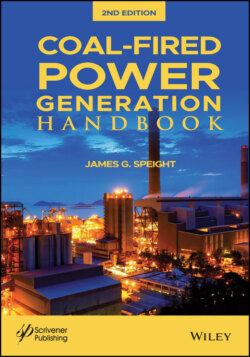Читать книгу Coal-Fired Power Generation Handbook - James Speight G., James G. Speight - Страница 41
2.4 Coal Petrography
ОглавлениеCoal is an extremely complex heterogeneous material that requires several parameters for chemical and physical characterization (Chapters 5, 6) – one single parameter is completely lacking for the true characterization of coal. However, the standard method of characterizing the organic (maceral) and the inorganic (mineral) constituents of coal is known as coal petrography (Speight, 2013 and references cited therein).
Coal petrography is the description of the components of coal as studied macroscopically and in thin and polished sections under the microscope. As the use of such methods became more common, coal petrography became concerned with the composition, structure, and origin of coals. In other words, it developed into the field of coal petrology. The principal task of coal petrology is the study of the elementary components of the organic matter of coal beds. These components are the remains of plants, which, in the process of biochemical decomposition into the peat stage of coal formation, lost or preserved to some extent their form and structure. A distinction is made here between the tissue elements and the matrix, which, taken together, constitute the components of coal. Also, macro- components, such as vitrain and fusain, are distinguished from micro-components, such as spores and cuticles.
Coal petrography employs various methods of investigation. In methods of optical microscopy, for example, the specimen may be viewed in air or in immersion; both transmitted-light and reflected-light methods are used, and the light may be ordinary, polarized, or ultraviolet. Specimens may be separated into groups of components of similar density in heavy liquids (mixtures, for example, of carbon tetrachloride tribromomethane). Depending on the source material and the conditions of the transformation of this material (in the so-called peat stage of coal formation) the micro-petrographic components are classified into three basic groups (vitrinite or gelinite, fusinite, and liptinite) (Table 2.9). The composition of the source plants and the quantitative relations between micro-petrographic components determine the genetic types of coal, which are characterized by definite chemical and technological properties within each stage of coalification.
Thus, coal petrology is the science in which coal type is related to the type of plant material in the peat and the extent of the biochemical and chemical alteration. Type can be assessed in terms of variety of petrographic analysis. Coal petrology is concerned with the origin, composition and properties of the distinct organic and inorganic components of different coals. To date, the principal practical application of coal petrology has been in the specification and selection of coals for carbonization (Speight, 2013 and references cited therein).
From the data obtained from coal petrology, the rank (defined by vitrinite reflectance) and composition (maceral proportions) of coal can be determined. Coal macerals are optically homogenous, discrete microscopic constituents of the organic fraction of coal, and they constitute the building blocks of coal and are identified and classified on the basis of their morphology, source material, color/level of reflectivity, and nature of formation. Macerals differ because they represent different part of the plant material and microorganisms. From petrographic studies, coal is shown to comprise three main mac-eral groups: (i) the vitrinite group, (ii) the exinite group also known as the liptinite group, and (iii) the inertinite group.
Table 2.9 Nomenclature and Sub-division of the Various Maceral Groups.
| Maceral group | Maceral | Origin |
| Vitrinite | Telinite | Humified plant remains typically derived from woody, leaf, or root tissue with well to poorly preserved cell structures |
| Collinite | Humified material showing no trace of cellular structure, probably colloidal in origin | |
| Vitrodetrinite | Humified attrital or less commonly detrital plant tissue with particles typically being cell fragments | |
| Liptinite (exinite) | Sporinite | Outer casing of spores and pollens |
| Cutinite | Outer waxy coating from leaves, roots, and some related tissues | |
| Resinite | Resin filling in cells and ducts in wood; resinous exudations from damaged wood | |
| Fluorinite | Essential oils in part; some fluorinate may be produced during physicochemical coalification and represent nonmigrated petroleum | |
| Suberinite | Cork cell and related issues | |
| Bituminite | Uncertain but probable algal origin | |
| Alginite | Tests of some groups of green algae; material referred to alginate shows moderate to strong fluorescence | |
| Exudatinite | Veins of bitumen-related material expelled from organic matter during coalification | |
| Liptodetrinite | Detrital forms of liptinite that cannot be differentiated | |
| Inertinite | Fusinite | Wood and leaf tissue oxidation |
| Semifusinite | Wood or leaf tissue weakly altered by decay or by biochemical alteration | |
| Inertodetrinite | Similar to fusinite or semifusinite but occurring as small fragments | |
| Macrinite | Humic tissue probably first gelified and then oxidized by processes similar to those producing semifusinite | |
| Sclerotinite | Moderately relflecting tissue of fungal origin, largely restricted to Tertiary coals | |
| Micrinite | Largely of secondary origin formed by disproportionation of lipid of lipidlike compounds |
